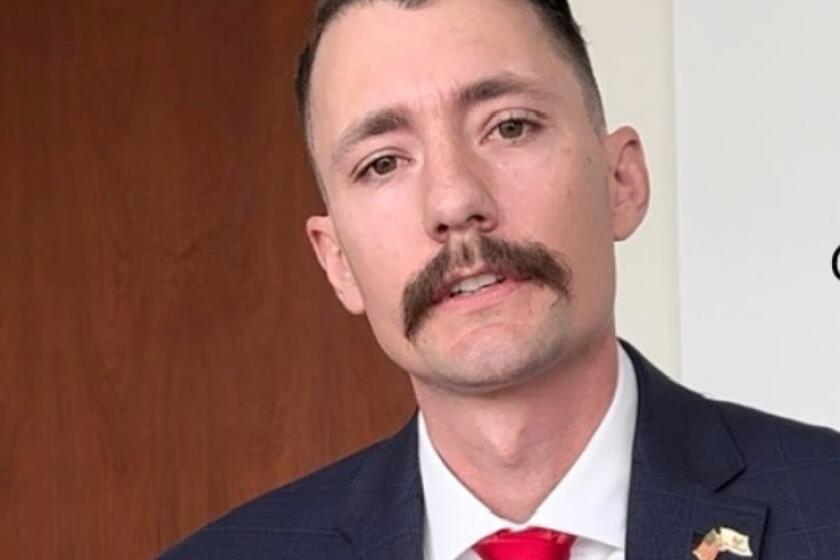Tourist of the Year
- Share via
My sister Emily felt it safe enough to fly down from Oakland the other day to visit L.A.
She telephoned first to make sure there wasn’t something going on that the media was covering up, like a hurricane or a civil war.
I assured her it was OK, that we were between disasters, but she’d better hurry. Two days later, she flounced into town like a Tourist of the Year and demanded to see the usual tourist attractions.
So I took her to the Valley to view the earthquake damage, to the mountains to view the fire damage and to South-Central to view the riot damage.
“I’d show you a carjacking in progress,” I said, “but they occur unannounced.”
Emily caught the sarcasm and glared at me the way she did when I was a kid and she was about to give me the Dutch rub for smarting off. It is a punishment by which the punisher rubs his knuckles against one’s scalp. Not exactly a caning with wet bamboo, but painful enough.
She was most interested in the riot area because it was the second anniversary of the worst urban uprising in the nation’s history this century, and she couldn’t understand why people would burn down their own neighborhood.
“A lot of experts are still trying to figure that out,” I said. “Unemployment, poverty, frustration . . . maybe all those things. It was the moral equivalent of a scream in the night.”
“You talk like a writer,” Emily said.
“That’s because I am one. If I were an opera star, you’d get an aria.”
*
South-Central bustles today with the same kind of activity that characterizes most communities in L.A.
The signs of the riots have mostly disappeared. There’s a gleaming newness to the main streets and intersections where fire and violence once prevailed.
I know despair exists in the neighborhoods, but it isn’t obvious. The boarded storefronts of small businesses blend into the environment.
Emily, however, wasn’t fooled. “There are a lot of vacant lots with fences around them,” she said as we drove slowly up one street and down another. “They look sad.”
There are 391 vacant lots to be exact, Linda Griego would tell me later. She’s executive director of Rebuild L.A., an agency that carries the vacancies on its shoulders.
The lots are RLA’s symbols of despair, empty places to be filled with life-sustaining commerce, gaps in a social order that owes its people jobs.
I explained to Emily the lots were once occupied by grocery stores and gas stations, pharmacies and coffee shops that had been burned to the ground and never rebuilt, for a lot of reasons.
“I saw them burn,” I said to the Tourist of the Year. “I saw them being looted. Now the burners and the looters are wondering why they did what they did. There may never be answers.”
“There’s pride in jobs,” Emily said, from out of that place in her that remembers the Great Depression. “It’s what will make the difference here.”
*
When I first began touring with Emily I resented her interest in a situation that is nothing to boast about. “Riot Capital of the World” will never be part of our logo.
But she was asking the kinds of questions everyone ought to be asking. Perhaps our urban chaos can offer lessons in progress that might defuse riots-in-waiting elsewhere.
One lesson is power. Not clenched-fist power, but the economic power that comes with combining 20 $1-million businesses in South-Central into a coalition of mutual interests with $20 million clout.
It’s what Linda Griego is trying to do. Ninety percent of those businesses hire less than 50 people. But merge their goals, share their costs and combine their skills, and you’ve got power to borrow, power to grow, power to put more people to work.
The lopsided, tear-stained, mega-liberal viewpoint of the documentary “The Fire This Time” is that nothing changed after the Watts riots and nothing is changing after the riots two years ago.
Documentarian Randy Holland’s film lacks the perspective of time. Things are changing, but slowly. Attitudes are changing. Realizations are changing. Barriers are coming down.
The length of a lifetime is a blink in the night. Hatreds and ignorance have been growing for many lifetimes in this country, and many more will pass before the idea of equality is achieved.
“What do you think of L.A. now?” I asked the Tourist of the Year.
Emily has never been effusive in her praise, so it was a triumph of optimism when she said, “I think I’ll come for another visit soon.” Then she added, “Perhaps next time you’ll show me a carjacking.”
I sure hope not.
More to Read
Sign up for Essential California
The most important California stories and recommendations in your inbox every morning.
You may occasionally receive promotional content from the Los Angeles Times.













